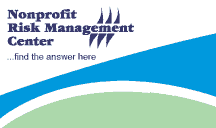|
November 19, 2008
Be Proactive in Times of Crisis
The unexpected happens. Even with insightful planning and sound risk
management—people are injured, fires destroy, and investments evaporate. When “stuff happens,” savvy nonprofits know that action is needed and that action has to be communicated to stakeholders. Speaking recently about the challenges posed by the economy, Rebecca Rimel, President of the Pew Charitable Trusts, stressed that clear and continual communication among the nonprofit’s staff, board and constituents is critical. How should difficult messages be crafted? Given the challenges that so many nonprofits are facing right now, we thought it was a good time to revisit some basic tenets about communicating with stakeholders in a time of crisis.
Imagine that your nonprofit is forced to suspend several programs to save costs and that this will result in a significantly reduced staff. It’s hard enough to deliver this message to staff, but you can also expect that the greater community, including donors and the media, will soon have questions. Are you prepared for the ensuing phone calls from the local newspaper?
Communication during a crisis should be carefully coordinated. Whether the communication is directed at an internal or external audience, and whether it is written, spoken, or has visual components (such as on a web site) the message needs to be clear and consistent among the different audiences.
 Here are tips drawn from the Center’s publication, Vital Signs—Anticipating, Preventing and Surviving a Crisis in a Nonprofit. Here are tips drawn from the Center’s publication, Vital Signs—Anticipating, Preventing and Surviving a Crisis in a Nonprofit.
Summary Statement—Prepare a short summary that says simply: what happened, what your nonprofit is doing about it, and how your organization feels about it. Express sincere concern for the well being of victims—don't be afraid to be compassionate. Since nonprofits are perceived as being in the “compassion business,” it would be inconsistent for any statement to appear unemotional. The most effective way to ward off ill-will, or even a lawsuit, is to express genuine care and concern.
Communicate a Plan—In times of crisis your stakeholders will want to know that there is a plan, both to move forward and to correct any past mistakes. Be transparent about what happened and show that the nonprofit is moving forward, having learned from the past. Having a plan inspires confidence. Sailing a rudderless ship does not.
Don’t Avoid Questions—Always tell the truth, and don’t appear to hedge or hide, no matter how uncomfortable the question. A crisis of confidence on top of the underlying crisis will only compound the difficulty of recovery. “ABC Nonprofit did not comment for this article” is not what you want the newspaper to report. As soon as you recognize that there is a problem, brainstorm what questions outsiders will ask, such as “Wasn’t there adult supervision on the trip?” “Did you know about the van driver’s drinking problem?” “How can you terminate these workers right before the holidays?” Preparing for those hard questions in advance is necessary to be ready with credible answers and explanations.
Tell Your Story—Control the message. If the crisis has attracted the attention of the media, you'll need a plan to keep the media informed of developments. A "media kit" should be prepared in advance for distribution in the aftermath of a crisis. The kit should include a fact sheet on the nonprofit’s mission, programs, sources of funds, as well as information about how the public benefits from the organization’s activities. Ideally, the “kit” should be maintained in electronic form and updated. Then, when a crisis hits, you have much of what you need. (Keep a hard copy on hand in case the crisis is accompanied by the loss of electronic data.) A significant element of the preparedness strategy is to determine who will serve as the spokesperson of the nonprofit. And it is a good idea to determine in advance which media outlets, and who at each outlet, should be contacted.
Whether your crisis is the sudden loss of a long-time beloved staff member of the unforeseen bankruptcy of a major donor, your goal is to avoid a loss of public confidence in your organization that interferes with your ability to return the focus to your mission. Have a plan for the future and tell your story—with clarity, consistency and compassion.
For more resources on leading a nonprofit through difficult times, the Center suggests this article, available from the “Library” section of our website: “Sustaining Nonprofits Through Economic Downturns.”
Have a question? Give us a call 202-785-3891 or send us an email to: info@nonprofitrisk.org
|



 Insurance Publication Now Available from the Center! Copies of the 2nd edition of the Center’s insurance text, Coverage, Claims and Consequences: An Insurance Handbook for Nonprofits are flying off the shelf!
Insurance Publication Now Available from the Center! Copies of the 2nd edition of the Center’s insurance text, Coverage, Claims and Consequences: An Insurance Handbook for Nonprofits are flying off the shelf!  Download the Center’s publication on special event risks:
The Center’s publication,
Download the Center’s publication on special event risks:
The Center’s publication,  Here are tips drawn from the Center’s publication,
Here are tips drawn from the Center’s publication,